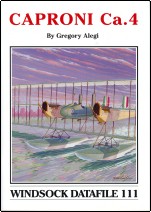|
Albatros Productions, Ltd. |
|
Windsock Datafiles #111 Caproni Ca.4 |
|
by Gregory Alegi |
|
Reviewed By Brian Baker, #43146 |
|
|
|
36 Pages plus 4 useful covers, 62 high quality photos, 8 pages of detailed 1/72
and 1/48 scale drawings, two pages of detailed sketches from the manufacturers, one cover painting, and three color profiles
showing Italian and British variants. MSRP £10.25 retail or £12.25 postpaid from the publisher at Albatros Productions. The Caproni Ca.4 was one of those unique but “might-have been” aircraft that arouse the interest of modelers and historians from time to time. Although at the present time there is no kit available of this aircraft that I am aware of, there is certainly enough information presented in this publication for one of the model manufacturers to rectify the situation. The Ca.4 was intended as the successor to the Ca.3 biplane heavy bomber produced by Caproni during 1916. The idea was to produce a truly colossal tri-motored tri-plane for long range bombing missions, a role previously performed mainly by hydrogen filled airships. The prototype took a year to construct, and first flew in July, 1916, where the test pilot reported the flying qualities as “marvelously good”. Test flights continued, and some minor modifications were made. Unfortunately, the original engines, Isotta Fraschini V5s, were not satisfactory, and replacements had to be found, with 400 hp Tosi and 500 hp Fiat A-14s being tried. The last variants used American Liberty engines. The airplane became a kind of political football, with the Italian military hedging on its promises, with only limited production of the type until late in the war, but it is known that at least six were delivered to the British for use in anti-submarine patrols, albeit from Italian bases, these being subsequently return to the Italians. Attempts were made to sell the design to the Americans, since earlier Caproni designs were to be produced in the United States. One Ca.4 was sent to the U.S. in 1917, but it crashed on takeoff due to engine failure, dashing Caproni’s hope to market the type in the U.S. The Ca.5 biplane was selected instead, although in the end, the contract was eventually cancelled. Finally, an Italian unit was selected to operate the Ca.4, and these aircraft began operations against the Austrians early in 1918. Some of their aircraft had been operated previously by the Royal Navy unit. The unit was finally disbanded in 1919. Postwar, the type was used for promotional tours and in attempts to break records, but its usefulness had passed. One survived in a museum until World War II, when it was presumably destroyed in an air raid. The Ca.4 must have been an impressive airplane to view in person, or even more to see flying overhead, especially in formation. Beset by development problems and political vacillations, only a few were actually built and used. It must have been hard work to fly the airplane, in a time before balanced or assisted control surfaces, and when large airplanes were notoriously underpowered. It must have been like flying an airplane with the size and weight of a DC-3 with the power of an AT-6. Postwar, a few were converted to airliners and actually put in service for a time, but the type could have hardly been profitable to operate, and they went out of use by 1923. Approximately 42 had been produced, of which six were operated by the Royal Navy Air Service. None survives today. In paperback format, this publication provides a lot of information about an airplane that until now has remained relatively obscure. The photographs and drawings are excellent, and the color information, in keeping with color data from that time period, is a little sparse. There really isn’t much of that information available, and black and white photos do not always provide much information. Nevertheless, there is enough here for the serious modeler to use in scratch building a model of this aircraft. The book provides a clear explanation of the technical development of this airplane, along with its service history. Detailed accounts of operational missions are provided, along with the aircraft’s role after the Armistice. From the writing, it must have frustrating indeed for the Capronis to deal with the Italian government bureaucracy and the people involved in the selection process for new aircraft types. The problem in providing information on the colors and markings of aircraft of this time period is the almost total lack of information other than black and white photos. As in the Brandenburg Datafile, the author explains the reasons for the lack of specific color information, and the methods he used to reach the conclusions that he did. However, three color profiles and a cover painting provide some useful information. The text is written in good technical style, and is interesting and informative. The photos are of uniformly high quality, and the captions are informative. The drawings are of the highest quality, and providing 1/72 and 1/48 scale is a good idea, as I can’t imagine anyone building one of these in 1/32 scale unless they rent a T-hangar at the airport to store it. Due to space limitations, some of the 1/72 views are not repeated in 1/48, but this is not a problem. One excellent feature of the text is a discussion of the historical research methods used to develop the material. Archival sources and a bibliography are provided, as well as sections on designation systems and technical data. I would certainly highly recommend this publication for anyone interested in World War I aviation, as well as those interested in building models of this type. |
|
Information, images, and all
other items placed electronically on this site |
